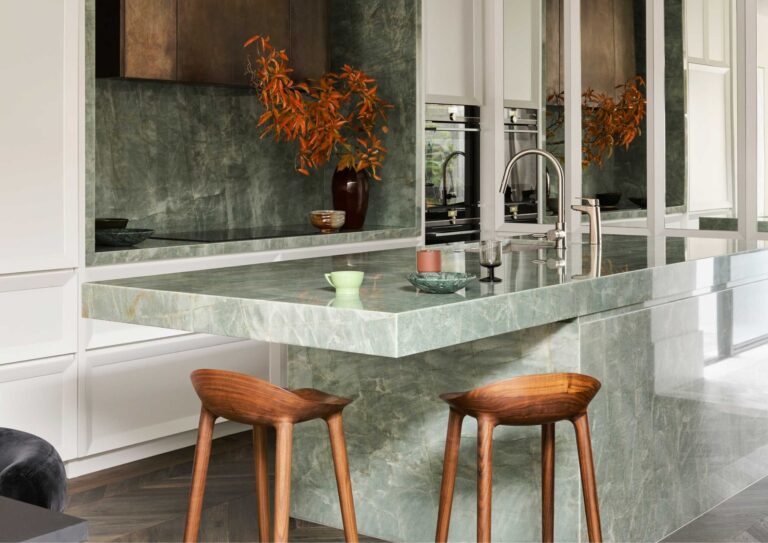Marble always comes to mind as one of the most recommended materials for kitchen countertops. marble kitchen countertop have been an emblem of luxury and elegance for a long time. This has led to it being highly preferred by homeowners because of its evergreen beauty and class.
Marble kitchen countertop comes with many advantages. This is what makes it strong enough for any home. Never underestimate it because it can just be perfect with your kitchen design .
However, there are a number of things that you should consider before purchasing a marble kitchen countertop for your kitchen. This article will highlight some of the facts about marble kitchen countertops which will enable you to make an informed decision. The purpose is to ensure they match with your needs and way of life.
1. Does The Marble Kitchen Countertop Have To Be Sealed?
Video Credit: Matt Hess
Ever feel a little lost when it comes to home maintenance? You're not alone! Especially with beautiful yet delicate materials like marble countertops, the question of sealing can be a mystery. But worry not, because the answer is a resounding yes, you definitely need to seal your marble countertop!
Here's why: Marble is naturally porous, meaning it has tiny holes that can trap liquids. These liquids can cause stains, etch the surface (think water rings!), and even lead to further damage. Sealing acts like a suit of armor for your countertop, minimizing those pesky pores and creating a protective barrier. Spills? No problem! Stains? Not a chance!
So, where should you absolutely seal your marble? Kitchens and dining areas are prime targets. Just imagine a glass of red wine taking a tumble – with a sealed countertop, you can breathe a sigh of relief.
Now, about resealing – how often is that necessary?
The truth is, it depends on a few factors like the type of marble, its finish, and how heavily you use your countertops. Generally speaking, resealing every 6 to 12 months is a good rule of thumb. But if you're unsure, there's a handy trick:
The Water Test
Drip a little water onto your countertop. If it beads up and rolls off, you're good to go! But if the water seeps in, it's time for a resealing refresh.
Still feeling a little lost? Don't fret! Your countertop supplier is a wealth of knowledge. They can advise you on the specific sealing methods for your unique marble and provide guidance on the best products to use.
With proper sealing, your marble countertop can stay stunning for years to come. So, go forth and conquer those spills with confidence!

Think sealing your marble countertop requires a team of hazmat-suited professionals? Think again! This is a DIY project you can conquer with confidence. Here's the lowdown:
Sealant Selection is Key: Don't grab just any bottle! Look for a sealer specifically formulated for natural stone surfaces like marble. These are designed to work their magic without harming your countertop.
Instructional Inspiration: Every superhero needs a guide, and yours is the manufacturer's instructions. Read them carefully – they'll be your roadmap to success.
The Sealing Showdown: Here's a sneak peek at the battle plan (though it may vary slightly depending on your chosen product):
- Spray It On: Like a gentle mist, apply the sealant in a light, even layer across the entire surface.
- Buff It Out: Grab a soft cloth (think microfiber for ultimate gentleness) and buff the sealant into the marble. Imagine you're giving it a loving massage!
- Soak it Up: Give the sealant some time to penetrate the stone, following the recommended dwell time on the instructions.
- Wipe Away Excess: Before your newfound friend dries completely, use a clean cloth to remove any excess sealant. You don't want a sticky situation!
2. Finishes And Edge Treatments For Marble Kitchen Countertops

So you've chosen the perfect marble countertop – a timeless symbol of luxury in your home. But wait, the journey doesn't end there! The world of marble offers a stunning array of finishes and edges, each adding a unique touch to your design. Let's delve into this design duo and explore how they can elevate your space.
The Finishing Touch: Polished vs. Honed
- Polished Finish: Imagine a mirror reflecting the light, showcasing the mesmerizing veins of your marble. That's the magic of a polished finish! It creates a dazzling, smooth surface that's a breeze to clean. Ideal for those who love a high-shine look.
- Honed Finish: Craving a more understated elegance? The honed finish delivers a beautiful matte or satin-like texture. Not only does it hide minor scratches more effectively, but it exudes a sophisticated, low-key vibe that complements various design styles.
The Edge of Perfection: Choosing Your Countertop's Profile
The edge profile you choose goes beyond aesthetics – it also impacts functionality and maintenance. Here are some popular options:
- Bullnose Edge: This classic, rounded edge adds a touch of softness and is comfortable to lean against. Plus, it's easy to clean.
- Straight Edge: A clean, contemporary look perfect for modern kitchens. Keep in mind, however, that straight edges can be more prone to chipping.
- Quarter Round: A subtle curve that offers a touch of detail without being overly ornate. It's also a good middle ground between a bullnose and straight edge in terms of cleaning and durability.
3. Cleaning And Maintenance For Marble Kitchen Countertops
Video Credit: Always Be Learning
marble countertops – the epitome of luxury and elegance in any kitchen. But with great beauty comes great responsibility (or at least, a little care). The good news? Keeping your marble masterpiece sparkling doesn't require a team of cleaning ninjas. Here's your essential guide to maintaining that marble shine:
Daily Defense:
- Wipe Out the Ordinary: Make a habit of giving your countertops a daily swipe with a soft, damp cloth or sponge. This tackles everyday crumbs, spills, and dust before they can become a bigger issue.
- Ditch the Abrasives: Think of your marble as a delicate work of art. Harsh cleaners and abrasive sponges are a big no-no, as they can scratch the surface. Opt for gentle cleaners specifically formulated for natural stone.
- Acid Alert! Marble and acidity are not best friends. Avoid harsh cleaners and acidic foods (like citrus juices or tomato sauce) sitting on the surface for extended periods. These can cause etching or discoloration.
Spills Happen: How to Be a Blotter Master
Spills are inevitable, but you can prevent them from becoming permanent stains. Here's the golden rule: blot, don't wipe! Wiping can spread the liquid and increase the chance of staining. Instead, use a clean, absorbent cloth to gently blot the spill. The faster you act, the better!
4. What Causes Marble To Turn Yellow Over Time

Marble countertops – a timeless symbol of luxury in your kitchen. But over time, that pristine white glow can fade, morphing into a less-than-desirable yellow hue. Fear not, homeowner extraordinaire! Let's unravel the secrets behind marble yellowing and equip you with the knowledge to keep your countertops sparkling bright.
The Culprits of Color Change:
- Water Woes: While marble is undeniably beautiful, it's not the biggest fan of constant moisture exposure. Light-colored marbles are particularly susceptible – prolonged contact with water can lead to yellowing.
- Chemical Combat: Harsh cleaners with bleach or acidic ingredients are kryptonite to marble. These can cause etching and discoloration, including that dreaded yellow tinge. Remember, even seemingly harmless acidic foods like citrus fruits or tomato sauce left to linger can contribute to the problem.
- Iron Oxidation: Marble can naturally contain iron deposits. When exposed to air and moisture, this iron oxidizes, leading to a yellowing effect.
- Seal Failure: Think of your marble's seal as a protective shield. Over time, it can weaken or wear thin. This allows water and other harmful liquids to seep into the stone's porous surface, potentially causing yellowing.
- Cleaning Neglect: Let's face it, life gets busy, and sometimes countertop cleaning falls by the wayside. A build-up of grime and substances can also contribute to a yellowing appearance.
Conquering the Yellowing Curse:
Now that you know the enemies, here's how to fight back:
- Routine Cleaning: Make daily wipe-downs with a soft, damp cloth a habit. This removes spills and debris before they have a chance to cause trouble.
- Cleaning with Care: Ditch the harsh chemicals! Opt for gentle, natural stone-safe cleaners.
- Seal and Repeat: Resealing your marble countertops periodically is crucial. Consult a professional or your stone supplier for guidance on the best products and frequency for resealing.
- Act Fast on Spills: Don't let spills become permanent stains. Blot up liquids immediately with a clean, absorbent cloth.
5. Will Marble Kitchen Countertop Chip Easily?

Marble countertops – a timeless symbol of elegance that elevates any kitchen. But like all things beautiful, marble requires a touch of TLC. Here's the key difference to remember: compared to granite or quartz, marble is a bit softer. Think of it as a luxurious cashmere sweater – stunning, but needs a gentle touch.
Protecting Your Marble Masterpiece:
- Handle with Care: Those heavy pots and pans? Best to lower them gently onto the countertop. A flying dutch oven can cause chips, so a little caution goes a long way.
- Mind What Lands There: While marble is undeniably gorgeous, it's not invincible. Hot cookware can leave heat marks, and acidic foods like citrus fruits or tomato sauce can etch the surface. Use trivets and cutting boards to be your marble's best friend.
Minor Mishaps? Don't Panic!
Let's face it, accidents happen. If you do encounter a minor chip, there are DIY solutions available (consult a hardware store for specific products). But here's the truth: prevention is always better than repair.
By being mindful of how you use your marble countertop, you can keep it looking flawless for years to come. Remember, a little extra care goes a long way in preserving this luxurious natural stone!





